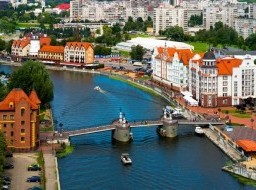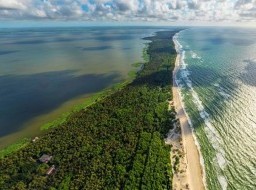Kaliningrad
Kaliningrad is the centre of the most western Russian region which plays a unique role in the commercial interaction between Russia and Europe. Overlooking the Baltic Sea, the Kaliningrad region boasts some striking scenery. Among the region's attractions, you'll find a vibrant city with 700 years of Prussian history, pleasant coastal towns facing the sea, and the wild Curonian spit, a narrow landmass lined with some of Europe's highest sand dunes, deserted beaches and verdant marshland. You'll also find a colorful array of wildlife hidden in the region's thick forests. Kaliningrad has been founded by the Teutonic knights when they conquered the coast of the Baltic Sea in the XIII century. Poland called them for help in order to repress the uprising of the Bruzi, the inhabitants of this part of the kingdom, whose name is at the origin of the name of Prussia. The Teutonic knights were charged to evangelize the pagan people. Poland had promised to the Great master of the Teutonic order, Hermann von Salza, that the conquered land would belong to the Knights. Konigsberg, as the city of Kaliningrad was once known, was founded on September 1st, 1255. Its capital, now named Kaliningrad, was the famous German city of Konigsberg, capital of East Prussia, where Prussian kings were crowned. The city’s initial infrastructure development was mainly due to joining the Hanseatic League of the Baltic Cities. In 1544, Albertina, a university named after Duke Albrecht was founded. The German philosopher Immanuel Kant studied and then taught in this university. Yet more than its natural wonders, Kaliningrad is known for its history, which differs markedly from the rest of Russia. From the 13th century until 1945, the entire region was German, part of the core territory of the Teutonic knights and their successors, the dukes and kings of Prussia. Konigsberg was involved in the Polish-Lithuanian Teutonic war, the Thirty Years' War between the Teutonic Order and Poland, the Second Northern War, the Seven Years’ War, the World War 1. Starting from August 1946 the city was actively repopulated with people from other regions of the USSR. This determined the structure of the multinational population of the region and the formation of a peculiar type of culture, which is characterized by interaction and interpenetration of traditions and customs. The town has been rebuilt in a typical Soviet style and renamed Kaliningrad after Mikhail Kalinin, the President of the Supreme Soviet during many years, an only honorific position. The intertwinement of the Russian and European cultures and histories predetermined a specific culture and European–type mentality of Kaliningradians. Scant Prussian legacy remains in the city of Kaliningrad, but the countryside is sprinkled with picturesque, moss- covered ruins of Prussian castles. Kaliningrad is also Russia's smallest, newest and most westerly province. The world's largest amber mine, which still produces 90% of the world's amber, lies in Kaliningrad (in Yantarny). Amber is a fossilized resin, which is found principally in the sediment of the shores of the Baltic Sea. Scientists began to study it a long time ago: Aristotle described it in his books. However, its systematic study started only during the XVIII century. The Russian scientist Lomonosov first asserted that it was a resin coming from a tree. Today it is well known that amber is the testimony of the big forests of conifers, which spread in Northern Europe a long time ago. Amber mine Yellow amber is used since the IIIrd millennium for decorative and curative purposes. During the Antiquity, it was the subject of an important trade. A stone borne from water, a stone which imprisons life, with its inclusions of insects, a burning stone, a stone which attracts light objects after craping, amber is an ambiguous material which inspired various legends. Our ancestors explained the origin of amber with the history of Phaeton, Hellos’ son. One day, Hellos allowed his son to drive his cart. However, Phaeton, in his clumsiness, drove the cart to close to the earth, putting it into great danger of a terrible drought. In order to stop this disorder, Zeus threw his lightning on the cart. Amber digger Phaeton fell in a river and died. Gods felt sorry for his sisters’ inconsolable sorrow and transformed them into trees. Young girls’ tears were as much drops of resin, which became pieces of amber. This legend and many other beliefs, which attributed magical and curative powers to amber, developed active arts and crafts that are still vivid today in jewelry. |







